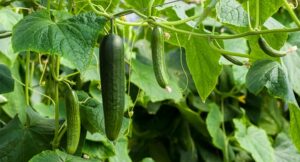Easy Steps to Growing Cucumbers

Cucumbers are scientifically known as Cucumis sativus this veggie/fruit belongs to the same family ( Cucurbitaceae family) as squash, cantaloupe, and watermelon. Cucumbers have many benefits and can be eaten raw in salads, alone, and on sandwiches, and can also be fermented or pickled. Cucumbers are mostly water 95% making this veggie a good food for hydration.
Cucumbers are native to India and from ancient records, cucumbers are said to have been a staple food of the Egyptians for more than 3000 years. Cucumbers are considered to be an annual and are easy to grow so if it’s your desire to grow this veggie from your home garden then continue reading as we discussed how to grow cucumbers in a garden.
Affiliate Disclaimer
As the owner of this website, I’ve tracked down special deals for some of the products mentioned here. When you use the links on this page to make a purchase I may get a small commission and you will get a great bargain. It’s a WIN-WIN for both of us.
Cucumber Planting Location
To reap a good harvest cucumbers must be installed in an area that gets full sunlight, at least 6-8 hours of sunlight per day is sufficient for cucumbers to grow healthy.
Cucumber Soil Type
Cucumbers love well-drained fertile soil, to build your native soil or to condition your soil for a better harvest mix in organic matter or aged compost. A pH of 6.0-6.8 is ideal. If planting cucumbers from seeds in rows the seeds should be planted 10-12 inches apart, and each row should be spaced 18-24 inches apart, however, when planting cucumbers in groups the seeds should be planted in groups of 3 with a distance of 18 inches between each group in all directions.
It is better however to grow cucumbers using a trellis because, when growing cucumbers on a trellis you will get a better yield than let’s say allowing cucumbers to grow at the ground level. By growing upward instead of outward your cucumber will produce more per square foot, a trellis will also help to direct the vines and cucumbers will be less susceptible to diseases vs making contact with the ground or growing at ground level. Cucumbers will also be easier (growing on a trellis) to harvest.
How to Water Cucumber
Proper watering methods are so important when it comes to the growth and the care of cucumbers, if cucumbers are not watered on a regular basis or as scheduled will taste bitter. Cucumbers must be watered consistently with at least 1 inch of water per week or more if the temperatures are high.
How to Fertilize Cucumber
Fertilizing your cucumbers is so important and this should not be overlooked, the use of worm casting, compost tea, or a high-quality water-soluble organic fertilizer will help greatly. Fertilize your cucumbers every 10-14 days for the first 8-12 weeks to encourage stronger growth and bigger yields.
Cucumber Garden Pests
The main pests problem for cucumbers are aphids, whiteflies, squash bugs, and cucumber beetles aphids are tiny pared shape insects that dose damage by piercing the plant and sucking its juice or fluids. The excrement of aphids is sticky and is known as honeydew which a black mold forms are known as sooty mold. Signs of the presence of aphids are leaves that turn yellow, distorted flowers/fruits, and a sticky substance that we discussed earlier known as honeydew which is the excrement and black (sooty mold) mold.
To bring aphids under control knock them off with a strong spray of water, or apply insecticidal soap, before applying insecticidal soap read and follow the manufactures directions for the best results.
Whiteflies: are another pests that can become a real issue if control measures are not taken right away, this garden pest is small and white, if the plant is disturbed and whiteflies are present they will fly rather quickly from the cucumber plant. Buts as quickly as they fly from cucumbers they will reattach themselves to cucumbers again. These insects do the same damage as aphids by sucking the sap.
Other signs include honeydew which is a sticky substance along with black (sooty mold) mold, and plants are distorted, wilt, and stunted. The leaves also develop areas that are yellow/silver. The presence of beneficial insects will bring control, during the morning hours spray the leaves’ undersides with water, this move will knock them off, the use of insecticidal soap can help also, or the use of yellow stick traps, a vacuum can remove whiteflies as well.
Cucumber beetles: signs of this garden pest includes holes in the flowers and leaves, stunted plants, and Bacterial wilt signs, which may lead to the death of plants. Destroy plants that are infected with Bacterial wilt, use row covers, and mulch heavy.
Squash bugs: damage include fruits that are scarred, the leaves wilt, and leaves will also have many tiny spots that are yellow/brown and black. Make sure that the plant beds are clean at all times, and search for the eggs on the undersides of the plant’s leaves, the eggs are in clusters and have a yellow/bronze appearance. Once the eggs are found they can be crushed. Crop rotation and the use of row covers will bring control.
Damage includes holes in the leaves and the flowers, plant wilts that are stunted, and plants that are infested with bacterial wilt must be properly disposed of. To help to protect plants mulch heavily and also use row covers.
Cucumber Diseases
There are certain diseases if not brought under control can become serious issues with cucumber plants.
Downy mildew: is a fungus, symptoms of this disease are the upper leaf surface develops angular spots that are yellow and then turn brown. The leaf undersides have a gray cottony growth that is also purple/white. The leaves become distorted follow by defoliation, control this disease by removing debris keeping the beds clean, avoid overhead irrigation or watering. Ensure there is good air circulation or plant-resistant varieties.
Powdery mildew: which is encouraged by fungus shows up as white spots on the upper leaf surface, the leaves will be coated with a flour-like substance. The leaves and the flowers may be stunted and distorted. The plant leaves turn yellow followed by death, choosing resistance varieties is the best option against this disease, ensure that plant is installed in full sunlight along with good air circulation. Plants should be sprayed with 1 teaspoon of baking soda dissolved in 1 quart of water.
Anthracnose: is a fungus, symptoms show up as yellow/brown/black/purple spots on the leaves, the stems, and the fruits develop sunken dark spots. Rot may even set in. The best choice is to choose variety resistance plants, rotate crops, avoid overhead watering, provide good drainage, and apply mulch and compost. Dispose of infected plants
Cucumber mosaic virus: signs of this virus are mottled, stunting white, yellow, and green ringed spots on the fruits and the leaves, fruits develop warts and the leaves are distorted. Choose a variety that is resistant to this disease, if the plant is infected destroy it. Use mulch, disinfect tools, keep beds free of weeds, use virus-free seeds, control aphids, and use row covers.
Blossom end rot: the blossom and the end of the fruit develop spots that are dark and water-soaked, and the stem that’s opposite may become leathery, enlarged, and sunken. This issue is brought on by a lack of calcium and insufficient water, plant at the proper soil temperature water deeply and evenly maintain proper soil pH and nutrient levels around the plant, use mulch, prevent damage to the plant’s roots, provide good drainage and avoid applying nitrogen to heavily.
Harvesting Cucumbers
Cucumbers can be harvested when they reach at least 6-8 inches in length or when they are big enough, when the cucumbers begin to appear check the vines daily. Be on the lookout for cucumbers that’s has dark green skin and are firm. To remove your cucumbers from the vine simply use a knife or clipper and cut the stem above the cucumber. Do not wait too long to harvest because cucumbers can become oversize with a bitter taste, the more cucumbers are harvested the more they will produce.
How to Store Cucumbers
Cucumbers can be stored in the refrigerator anywhere from 7-10 days, another option is to store whole cucumbers in air-tight zip lock bags in the fridge or wrap cucumbers in plastic. Portions of cucumbers that’s been sliced but not used can be covered in plastic wrap to discourage dehydration.
Cucumber Varieties
There are so many varieties of cucumbers here are just a few to consider planting for a good harvest.
Gardening -Guru
My Friend Stephen.
Stephen is a friend of mine who lives in Vietnam
He, like me, is crazy about gardening and I strongly recommend you check out his website. Here is something he has written about how to grow cucumbers. And he has a lot of other blogs as well. Take the time and look at his website today. I promise you it is worth the time and effort.
For great tips on how to grow cucumber please check it out here. ” How To Grow Cucumbers “
- Long green improved
- Diva
- Sugar Crunch
- National Pickling
- Burpless #26
- Salad Bush
- Boston Pickling
- Tendergreen Burpless
- Homemade Pickles
- Sweet Success
- Spacemaster
The final word on how to grow cucumbers in a garden
There you have it, it’s that easy, growing and harvesting your cucumbers from your home garden can be so much fun as you watch your cucumber plants grow, providing you with a good harvest. Cucumbers have so many health benefits, if you have not as yet then why not consider growing cucumbers or you may be growing them and need a few extra tips for a good harvest? Look no further because you have come to the right place for good success. With that said let’s get started on those cucumbers to reap a bountiful harvest.
About the author
Norman loves being in the garden, both at home and for his job....
he is 'Natures Little helper' being outdoors, growing his vegetables and flowers from an early age.
Now having spent over 22 years in the profession he want to give some of his knowledge to others...
his vast array of hints and tips you will find scattered over this site will help you no end growing plants in your garden.

